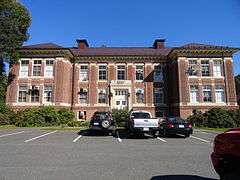Fernald Hall
Fernald Hall is the primary lecture hall and laboratory used by the entomology program of the University of Massachusetts Amherst. The building also houses the university's extensive collection of domestic and foreign insects.
| Fernald Hall | |
|---|---|
 The front entrance to Fernald Hall. | |

| |
| General information | |
| Type | Academic offices, classrooms, and research laboratories |
| Architectural style | Classical revival |
| Current tenants | Entomology Plant Pathology |
| Construction started | 1909 |
| Completed | 1911 |
| Technical details | |
| Floor count | 4 |
| Design and construction | |
| Architect | Clarence P. Hoyt, Boston |
| Main contractor | Allen Brothers, Amherst |
History
In the early days of the Massachusetts Agricultural College, there were relatively few places to house the college's new aspiring science departments. Many of the earliest homes to the natural science programs and their collections were small wooden buildings that were notorious for catching fire.[1] In the spring of 1907 it was decided that a natural sciences building should be conceived rather than an additional agricultural building as the trustees were concerned about safely storing the college's growing collections. In the fall of 1908, five architect's proposal's were presented to the president and department heads of the time, who decided on a design by Clarence P. Hoyt of Boston. In the following year, a total of $80,000 was appropriated for the construction of the new building.[1]
Built in 1910 as this biological sciences building, Fernald Hall would become the permanent home for the Massachusetts Agricultural College's expanding entomology department. The hall was dedicated to longtime faculty member and economic entomologist Charles H. Fernald in March 1921, even though the college had a rule that no buildings were to be named for a person until after their death; on January 7, 1921, President Kenyon L. Butterfield and the trustees of the college waived that rule in order to tell Fernald, who was in very poor health at the time, about the future naming of the building.[1] His son, Henry T. Fernald, also served as a professor and the department head between 1899 and 1930.[2]
Within the year of the building's completion, the college constructed the apiary to serve as a laboratory where bees could be raised without causing the potential problem of stings and swarming. Over the years several other bug species would be raised in Fernald for class demonstrations and research purposes.[2]
At some point since its construction the building underwent an expansion with the addition of a third floor, the installation of several new hallway skylights, and the expansion of its main lecture hall. These additions appear to have been sometime prior to a renovation in 1979.[3]
Layout
The first floor contains the main office of Tick Report as well as several faculty offices, and class laboratories. The main lecture hall of the building has an entrance on this floor; the basement contains several research laboratories.
The second floor is home to the university's 100,000 insect reference collection, which contains many specimens from different parts of the world on display in its hallways. There are also several live specimen terrariums on display in these cases as well. Many of the faculty offices are on this floor as well as labs used for teaching the medical entomology and insect anatomy classes.[4]
The third floor is currently sealed off from faculty and students due to building code violations. It contains several former graduate student offices, a photographic studio with a dark room[5] and additional storage for the university's insect collections.
See also
References
- Fernald, Henry T. The History of Entomology at the Massachusetts Agricultural College, 1867-1930. Amherst: Fernald Club, Special Publication Number 1, Massachusetts State College.
- "Apiary". Massachusetts Historical Commission, UMass Amherst, Building Survey. University of Massachusetts Amherst. Archived from the original on 30 September 2011. Retrieved 27 January 2011.
- "Fernald Hall". University of Massachusetts Amherst. Retrieved 27 January 2011.
- Goldscheider, Eric (April 16, 2006). "Pack a Bag and Head to UMass-Amherst; Views, Bugs, and Rare Plants". Boston Globe. p. M7. Retrieved January 23, 2011.
- Martin, Esther Coffin (Winter 2005). "Portrait of a Naturalist". UMass Magazine. Archived from the original on 21 January 2005. Retrieved 27 January 2011.
External links
- Dept. of Plant and Soil Science, UMass Amherst
- Dept. of Entomology, UMass Amherst, merged with Dept. of PSIS in 2004.
- Photos taken by "unofficial campus photographer", entomologist and ornithologist Robert Coffin, whose photography studio resided in the building
